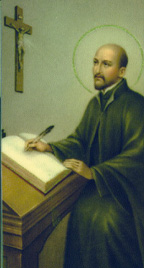
Feastday: July 31
Patron: Dioceses of San Sebasti
Born Inigo Lopez de Loyola in 1491, the man known as Ignatius of Loyola entered the world in Loiola, Spain. At the time, the name of the village was spelled "Loyola," hence the discrepancy. Inigo came of age in Azpeitia, in northern Spain. Loyola is a small village at the southern end of Azpeitia.
Inigio was the youngest of thirteen children. His mother died when he was just seven, and he was then raised by Maria de Garin, who was the wife of a blacksmith. His last name, "Loyola" was taken from the village of his birth.
Despite the misfortune of losing his mother he was still a member of the local aristocracy and was raised accordingly. Inigio was an ambitious young man who had dreams of becoming a great leader. He was influenced by stories such as The Song of Roland and El Cid.
At the age of sixteen, he began a short period of employment working for Juan Velazquez, the treasurer of Castile. By the time he was eighteen, he became a soldier and would fight for Antonio Manrique de Lara, Duke of Nájera and Viceroy of Navarre.
Seeking wider acclaim, he began referring to himself as Ignatius. Ignatius was a variant of Inigio. The young Ignatius also gained a reputation as a duelist. According to one story, he killed a Moor with whom he argued about the divinity of Jesus.
Ignatius fought in several battles under the leadership of the Duke of Najera. He had a talent for emerging unscathed, despite participating in many battles. His talent earned him promotions and soon he commanded his own troops.
In 1521, while defending the town of Pamplona against French attack, Ignatius was struck by a cannonball in the legs. One leg was merely broken, but the other was badly mangled. To save his life and possibly his legs, doctors performed several surgeries. There were no anesthetics during this time, so each surgery was painful. Despite their best efforts, Ignatius' condition deteriorated. After suffering for a month, his doctors warned him to prepare for death.
On June 29, 1521, on the feast of Saints Peter and Paul, Ignatius began to improve. As soon as he was healthy enough to bear it, part of one leg was amputated which while painful, sped his recovery.
During this time of bodily improvement, Ignatius began to read whatever books he could find. Most of the books he obtained were about the lives of the saints and Christ. These stories had a profound impact on him, and he became more devout.
One story in particular influenced him, "De Vita Christi" (The life of Christ). The story offers commentary on the life of Christ and suggested a spiritual exercise that required visualizing oneself in the presence of Christ during the episodes of His life. The book would inspire Ignatius' own spiritual exercises.
As he lay bedridden, Ignatius developed a desire to become a working servant of Christ. He especially wanted to convert non-Christians.
Among his profound realizations, was that some thoughts brought him happiness and others sorrow. When he considered the differences between these thoughts, he recognized that two powerful forces were acting upon him. Evil brought him unpleasant thoughts while God brought him happiness. Ignatius discerned God's call, and began a new way of life, following God instead of men.
By the spring of 1522, Ignatius had recovered enough to leave bed. On March 25, 1522, he entered the Benedictine monastery, Santa Maria de Montserrat. Before an image of the Black Madonna, he laid down his military garments. He gave his other clothes away to a poor man.
He then walked to a hospital in the town of Manresa. In exchange for a place to live, he performed work around the hospital. He begged for his food. When he was not working or begging, he would go into a cave and practice spiritual exercises.
His time in prayer and contemplation helped him to understand himself better. He also gained a better understanding of God and God's plan for him.
The ten months he spent between the hospital and the cavern were difficult for Ignatius. He suffered from doubts, anxiety and depression. But he also recognized that these were not from God.
Ignatius began recording his thoughts and experiences in a journal. This journal would be useful later for developing new spiritual exercises for the tens of thousands of people who would follow him. Those exercises remain invaluable today and are still widely practiced by religious and laity alike.
The next year, in 1523, Ignatius made a pilgrimage to the Holy Land. His goal was to live there and convert non-believers. However, the Holy Land was a troubled place and Church officials did not want Ignatius to complicate things further. They asked him to return after just a fortnight.
Ignatius realized he needed to obtain a complete education if he wanted to convert people. Returning to Barcelona, Ignatius attended a grammar school, filled with children, to learn Latin and other beginning subjects. He was blessed with a great teacher during this time, Master Jeronimo Ardevol.
After completing his primary education, Ignatius traveled to Alcala, then Salamanca, where he studied at universities. In addition to studying, Ignatius often engaged others in lengthy conversations about spiritual matters.
These conversations attracted the attention of the Inquisition.
In Spain, the Inquisition was responsible for ferreting out religious dissent and combating heresy. The Inquisition was not as it has long been depicted in the media.
The Inquisition accused Ignatius of preaching without any formal education in theology. Without this training, it was likely that Ignatius could introduce heresy by way of conversation and misunderstanding.
Ignatius was questioned three times by the Inquisition, but he was always exonerated.
Ignatius eventually decided he needed more education, so he traveled north, seeking better schools and teachers. He was 38 years old when he entered the College of Saint Barbe of the University of Paris. This education was very structured and formalized. Later, Ignatius would be inspired to copy this model when establishing schools. The ideas of prerequisites and class levels would arise from the Jesuit schools, which here heavily inspired by Ignatius' experience in Paris.
Ignatius earned a master's degree at the age of 44. When he subsequently applied for his doctorate, he was passed over because of his age. He also suffered from ailments, which the school was concerned could impact his studies.
While at school in Paris, Ignatius roomed with Peter Faber and Francis Xavier. Faber was French and Xavier was Basque. The men became friends and Ignatius led them in his spiritual exercises. Other men soon joined their exercises and became followers of Ignatius. The group began to refer to themselves as "Friends in the Lord," an apt description.
The circle of friends, shared Ignatius' dream of traveling to the Holy Land, but conflict between Venice and the Turks made such a journey impossible. Denied the opportunity to travel there, the group then decided to visit Rome. There, they resolved to present themselves to the Pope and to serve at his pleasure.
Pope Paul III received the group and approved them as an official religious order in 1540. The band attempted to elect Ignatius as their first leader, but he declined, saying he had not lived a worthy life in his youth. He also believed others were more experienced theologically.
The group insisted however, and Ignatius accepted the role as their first leader. They called themselves the Society of Jesus. Some people who did not appreciate their efforts dubbed them "Jesuits" in an attempt to disparage them. While the name stuck, by virtue of their good work the label lost its negative connotation.
Ignatius imposed a strict, almost military rule on his order. This was natural for a man who spent his youth as a soldier. It might be expected that such rigor would dissuade people from joining, but it had the opposite effect. The order grew.
The Society of Jesus soon found its niche in education. Before Ignatius died in 1556, his order established 35 schools and boasted 1,000 members. The order was responsible for much of the work of stopping the spread of the Protestant Reformation. The Society advocated the use of reason to persuade others and combat heresy.
Today, the Society of Jesus is known for its work in educating the youth around the world. Several universities have been founded in the name of Ignatius and in the traditional Jesuit spirit. The Jesuits also perform many other important works around the globe.
Ignatius' passed away on July 31, 1556, at the age of 64. He was beatified by Pope Paul V on July 27, 1609 and canonized on March 12, 1622. His feast day is July 31. He is the patron saint of the Society of Jesus, soldiers, educators and education.
16th-century Catholic priest, theologian and saint; founder of the Society of Jesus (Jesuits) In this Spanish name, the first or paternal surname is López de Oñaz and the second or maternal family name is Loyola.
Ignatius of Loyola (born Iñigo López de Oñaz y Loyola; Basque: Ignazio Loiolakoa; Spanish: Ignacio de Loyola; Latin: Ignatius de Loyola; c. 23 October 1491 – 31 July 1556), venerated as Saint Ignatius of Loyola, was a Spanish Basque Catholic priest and theologian, who together with Peter Faber and Francis Xavier founded the religious order called the Society of Jesus (Jesuits) and became its first Superior General at Paris in 1541. The Jesuit order is dedicated to teaching and missionary work. Its members are bound by a special (fourth) vow of obedience to the sovereign pontiff to be ready to fulfill special papal missions. The society played an important role during the Counter-Reformation.
Ignatius was noted as an inspired spiritual director. He recorded his method in a celebrated treatise called the Spiritual Exercises, a simple set of meditations, prayers, and other mental exercises, first published in 1548. It is known as "Ignatian spirituality".
Ignatius was beatified in 1609, and canonized, receiving the title of Saint on 12 March 1622. His feast day is celebrated on 31 July. He is the patron saint of the Basque provinces of Gipuzkoa and Biscay as well as of the Society of Jesus. He was declared patron saint of all spiritual retreats by Pope Pius XI in 1922. Ignatius is also the foremost patron saint of soldiers.
Early life
 Sanctuary of Loyola, in Azpeitia, built over Ignatius' birthplace
Sanctuary of Loyola, in Azpeitia, built over Ignatius' birthplace
Íñigo López de Loyola (more fully, de Oñaz y Loyola; sometimes erroneously called de Recalde) was born in the municipality of Azpeitia at the castle of Loyola in today's Gipuzkoa, Basque Country, Spain. His parents, Don Beltrán and Doña Marina, were of the minor nobiity. He was the youngest of thirteen children. His eldest brother, Juan Perez, died fighting in the Italian Wars under Gonzalo Fernández de Córdoba.
He was baptized Íñigo, after St. Enecus (Innicus) (Basque: Eneko; Spanish: Íñigo), Abbot of Oña, and an affectionate medieval Basque diminutive name meaning, "My little one". It is not clear when he began using the Latin name "Ignatius" instead of his baptismal name "Íñigo". Historian Gabriel María Verd says that Íñigo did not intend to change his name, but rather adopted a name which he believed was a simple variant of his own, for use in France and Italy where it was better understood. Íñigo adopted the surname "de Loyola" in reference to the Basque village of Loyola where he was born.
His mother died soon after his birth, and he was put in the care of María de Garín, the local blacksmith's wife. In 1498, his second eldest brother, Martin, now heir to the estate, brought his new wife to live at the castle. With a new mistress to manage the household, Íñigo, at the age of seven, returned to Casa Loyola. His father had the boy tonsured in anticipation of the possibility of his following a clerical career.
Military career
 Ignatius in armor, in a 16th-century painting
Ignatius in armor, in a 16th-century painting
 Saint Ignatius of Loyola's Vision of Christ and God the Father at La Storta by Domenichino
Saint Ignatius of Loyola's Vision of Christ and God the Father at La Storta by Domenichino
Instead, Íñigo became a page in the service of a relative, Juan Velázquez de Cuéllar, treasurer (contador mayor) of the kingdom of Castile. During his time in the household of Don Velázquez, Íñigo took up dancing, fencing, gambling, pursuit of the young ladies, and duelling. Íñigo was keen on military exercises and was driven by a desire for fame. He framed his life around the stories of El Cid, the knights of Camelot, and the Song of Roland, and other tales of romantic chivalry.
He joined the army at seventeen, and according to one biographer, he strutted about "with his cape flying open to reveal his tight-fitting hose and boots; a sword and dagger at his waist". According to another he was "a fancy dresser, an expert dancer, a womanizer, sensitive to insult, and a rough punkish swordsman who used his privileged status to escape prosecution for violent crimes committed with his priest brother at carnival time."
In 1509, aged 18, Íñigo took up arms for Antonio Manrique de Lara, 2nd Duke of Nájera. His diplomacy and leadership qualities earned him the title "servant of the court", and made him very useful to the Duke. Under the Duke's leadership, Íñigo participated in many battles without injury. However at the Battle of Pamplona on 20 May 1521 he was gravely injured when a French-Navarrese expedition force stormed the fortress of Pamplona, and a cannonball ricocheting off a nearby wall, shattered his right leg. Íñigo was returned to his father's castle in Loyola, where, in an era before anesthetics, he underwent several surgical operations to repair the leg, with his bones set and rebroken. In the end, the operations left his right leg shorter than the other. He would limp for the rest of his life, with his military career over.
Religious conversion and visions
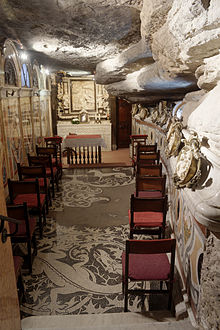 Manresa, Chapel in the Cave of Saint Ignatius where Ignatius practiced asceticism and conceived his Spiritual Exercises
Manresa, Chapel in the Cave of Saint Ignatius where Ignatius practiced asceticism and conceived his Spiritual Exercises
| Part of a series on | |||||||||||||||||||||||||||||
| Christian mysticism | |||||||||||||||||||||||||||||
|---|---|---|---|---|---|---|---|---|---|---|---|---|---|---|---|---|---|---|---|---|---|---|---|---|---|---|---|---|---|
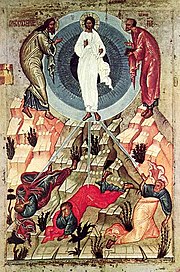 | |||||||||||||||||||||||||||||
Theology · Philosophy
|
|||||||||||||||||||||||||||||
Practices
|
|||||||||||||||||||||||||||||
People (by era or century)
|
|||||||||||||||||||||||||||||
Literature · Media
|
|||||||||||||||||||||||||||||
|
| Part of a series on the |
| Society of Jesus |
|---|
 Christogram of the Jesuits Christogram of the Jesuits |
| History |
|
| Hierarchy |
|
| Spirituality |
|
| Works |
|
| Notable Jesuits |
|
|
|
|
While recovering from surgery, Íñigo underwent a spiritual conversion and discerned a call to the religious life. His beloved sister-in-law, Magdalena de Araoz, chose to bring him texts to read which she knew would help him encounter the living God, while he was recuperating. Since the chivalric romances he enjoyed to read were not available to him in the castle, he came to read religious texts on the life of Jesus and on the lives of the saints.
The religious work which most particularly struck him was the De Vita Christi of Ludolph of Saxony. This book would influence his whole life, inspiring him to devote himself to God and follow the example of Francis of Assisi and other great monks. It also inspired his method of meditation, since Ludolph proposes that the reader place himself mentally at the scene of the Gospel story, visualising the crib at the Nativity, etc. This type of meditation, known as Simple Contemplation, was the basis for the method that St. Ignatius would promote in his Spiritual Exercises.
Aside from dreaming about imitating the saints in his readings, Íñigo was still wandering off in his mind about what "he would do in service to his king and in honor of the royal lady he was in love with". Cautiously he came to realize the after-effect of both kinds of his dreams. He experienced a desolation and dissatisfaction when the romantic heroism dream was over, but, the saintly dream ended with much joy and peace. It was the first time he learned about discernment.
After he had recovered sufficiently to walk again, Íñigo resolved to begin a pilgrimage to the Holy Land to "kiss the earth where our Lord had walked", and to do stricter penances. He thought that his plan was confirmed by a vision of the Virgin Mary and the infant Jesus he experienced one night, which resulted in much consolation to him. In March 1522, he visited the Benedictine monastery of Santa Maria de Montserrat. There, he carefully examined his past sins, confessed, gave his fine clothes to the poor he met, wore a "garment of sack-cloth", then hung his sword and dagger at the Virgin's altar during an overnight vigil at the shrine.
From Montserrat he walked on to the nearby town of Manresa (Catalonia), where he lived for about a year, begging for his keep, and then eventually doing chores at a local hospital in exchange for food and lodging. For several months he spent much of his time praying in a cave nearby where he practiced rigorous asceticism, praying for seven hours a day, and formulating the fundamentals of his Spiritual Exercises.
Íñigo also experienced a series of visions in full daylight while at the hospital. These repetitive visions appeared as "a form in the air near him and this form gave him much consolation because it was exceedingly beautiful ... it somehow seemed to have the shape of a serpent and had many things that shone like eyes, but were not eyes. He received much delight and consolation from gazing upon this object ... but when the object vanished he became disconsolate". He came to interpret this vision as diabolical in nature.
Period of studies
In September 1523, Íñigo made a pilgrimage to the Holy Land with the aim of settling there. He remained there from 3 to 23 September but was sent back to Europe by the Franciscans.
He returned to Barcelona and at the age of thirty-three attended a free public grammar school in preparation for university entrance. He went on to the University of Alcalá, where he studied Theology and Latin from 1524 to 1534.
There he encountered a number of devout women who had been called before the Inquisition. These women were considered alumbrados (Illuminati) – a group linked in their zeal and spirituality to Franciscan reforms, but they had incurred mounting suspicion from the administrators of the Inquisition. Once when Íñigo was preaching on the street, three of these devout women began to experience ecstatic states. "One fell senseless, another sometimes rolled about on the ground, another had been seen in the grip of convulsions or shuddering and sweating in anguish." The suspicious activity took place while Íñigo had preached without a degree in theology. As a result, he was singled out for interrogation by the Inquisition, but was later released.
Following these risky activities, Íñigo (by now Ignatius) moved to France to study at the University of Paris. He attended first the ascetic Collège de Montaigu, moving on to the Collège Sainte-Barbe to study for a Master's degree.
He arrived in France at a time of anti-Protestant turmoil which had forced John Calvin to flee France. Very soon after, Ignatius had gathered around him six companions, all of them fellow students at the University. They were the Spaniards Alfonso Salmeron, Diego Laynez, and Nicholas Bobadilla, with the Portuguese Simão Rodrigues, the Basque, Francis Xavier, and Peter Faber, a Savoyard, the latter two becoming his first companions, and his closest associates in the foundation of the future Jesuit order.
"On the morning of the 15th of August, 1534, in the chapel of church of Saint Peter, at Montmartre, Loyola and his six companions, of whom only one was a priest, met and took upon themselves the solemn vows of their lifelong work." Subsequently, they were to be joined by Francis Borgia, a member of the House of Borgia, who was the main aide to Emperor Charles V, and other nobles.
Ignatius gained a Magisterium from the University of Paris at the age of forty-three in 1535. In later life he would often be called "Master Ignatius" because of this.
Foundation of the Jesuit order
In 1539, with Peter Faber and Francis Xavier, Ignatius formed the Society of Jesus, which was approved in 1540 by Pope Paul III. He was chosen as the first Superior General of the order and invested with the title of "Father General" by the Jesuits.
Ignatius sent his companions on missions across Europe to create schools, colleges, and seminaries. Juan de Vega, then ambassador of Charles V, Holy Roman Emperor in Rome, met Ignatius there and having formed a good impression of the Jesuits, invited them to travel with him to his new appointment as Viceroy of Sicily. As a result, a Jesuit college was opened in Messina, which proved a success, so that its rules and methods were later copied in subsequent colleges. In a letter to Francis Xavier before his departure to India in 1541, Ignatius famously used the Latin phrase "Ite, inflammate omnia", meaning, "Go, set the world on fire", a phrase used in the Jesuit order to this day.
In 1548 Ignatius was summoned before the Roman Inquisition to have his book of Spiritual Exercises examined. He was eventually released and the book given papal permission to print. In their published form the exercises were intended to last for a period of 28–30 days.
With the assistance of his personal secretary, Juan Alfonso de Polanco, Ignatius wrote the Jesuit Constitutions, which were adopted in 1553. They created a centralised organisation of the order, and stressed absolute self-denial and obedience to the Pope and to superiors in the Church hierarchy. This was summarised in the motto perinde ac cadaver – "as if a dead body", meaning that a Jesuit should be as emptied of ego as is a corpse. However the overarching Jesuit principle became: Ad maiorem Dei gloriam ("for the greater glory of God").
During the years 1553–1555, Ignatius dictated his autobiography ("Autobiografía de San Ignacio de Loyola" in Wikisource in Spanish) to his secretary, Father Gonçalves da Câmara. It has become a companion volume to his Spiritual Exercises. It had been kept in the archives of the Jesuit order for about 150 years, before the Bollandists published the text in Acta Sanctorum.
-

Ignatius as Superior General
-

Statue of Saint Ignatius in the Church of the Gesù, Rome
Death and canonization
Ignatius died in Rome on 31 July 1556, probably of the "Roman Fever", a severe variant of malaria which was endemic in Rome throughout medieval history. An autopsy revealed that he also had kidney and bladder stones, a probable cause of the abdominal pains he suffered from in later life. His body was dressed in his priestly robes and placed in a wooden coffin and buried in the crypt of the Maria della Strada Church on 1 August 1556. In 1568 the church was demolished and replaced with the Church of the Gesù. Ignatius' remains were reinterred in the new church in a new coffin.
Ignatius was beatified by Pope Paul V on 27 July 1609, and canonized by Pope Gregory XV on 12 March 1622. His feast day is celebrated annually on 31 July, the day he died. He is venerated as the patron saint of Catholic soldiers, the Military Ordinariate of the Philippines, the Roman Catholic Archdiocese of Baltimore, in his native Basque Country, Antwerp, Belo Horizonte, Junín.
Legacy
Numerous institutions across the world are named for him, including many educational institutions. The Basilica of St Ignatius Loyola was built next to the house where he was born in Azpeitia, in the Basque Country. The house itself, now a museum, is part of the basilica complex.
In 1671, the mission in St. Ignace, Michigan was named in his honour, by Father Jacques Marquette.
In 1852, Loyola University Maryland was the first University in the United States to bear his name.
In 1949 he was the subject of a Spanish biographical film The Captain from Loyola starring Rafael Durán in the role of Ignatius.
In 2016, he was the subject of a Filipino film Ignacio de Loyola in which he was portrayed by Andreas Muñoz.
Ignatius of Loyola is remembered in the Church of England with a commemoration on 31 July.
Genealogy
 Original shield of Oñaz-Loyola.
Original shield of Oñaz-Loyola.
Shield of Oñaz-Loyola
The Shield of Oñaz-Loyola is a symbol of Ignatius family's Oñaz lineage, and is used by many Jesuit institutions around the world. As the official colors of the Loyola family are maroon and gold, the Oñaz shield consists of seven maroon bars going diagonally from the upper left to the lower right on a gold field. The bands were granted by the King of Spain to each of the Oñaz brothers, in recognition of their bravery in battle. The Loyola shield features a pair of rampant gray wolves flanking each side of a cooking pot. The wolf was a symbol of nobility, while the entire design represented the family's generosity towards their military followers. According to legend, wolves had enough to feast on after the soldiers had eaten. Both shields were combined as a result of the intermarriage of the two families in 1261.
Lineage
Villoslada established the following detailed genealogy of Ignatius of Loyola:
| Lineage | |||||||||||||||||||||||||||||||||||||||||||||||||||||||||||||||||||||||||||||||||||||||||||||||||||||||||||||||||||||||||||||||||||||||||||||||||||||||||||||||||||||||||||||||||||||||||||||||||||||||||||||||||||||||||||||||||||||||||||||||||||||||||||||||||||||||||||||||||||||||||||||||||||||||||||||||||||||||||||||||||||||||||||||||||||||||||||||||||||||||||||||||||||||||||||||||||||||||||||||||||||||||||||||||||||||||||||||||||||||||||||||||||||||||||||||||||||||||||||||||||||||||||||||||||||||||||||||||||||||||||||||||||||||||||||||||||||||||||||||||||||||||||||||||||||||||||||||||||||||||||||||||||||||||||||||||||||||||||||||||||||||||||||||||||||||||||||||||||||||||||||||||||||||||||||||||||||||||||||||||||||||||||||||||||||||||||||||||||||||||||||||||||||||||||||||||||||||||||||||||||||
|---|---|---|---|---|---|---|---|---|---|---|---|---|---|---|---|---|---|---|---|---|---|---|---|---|---|---|---|---|---|---|---|---|---|---|---|---|---|---|---|---|---|---|---|---|---|---|---|---|---|---|---|---|---|---|---|---|---|---|---|---|---|---|---|---|---|---|---|---|---|---|---|---|---|---|---|---|---|---|---|---|---|---|---|---|---|---|---|---|---|---|---|---|---|---|---|---|---|---|---|---|---|---|---|---|---|---|---|---|---|---|---|---|---|---|---|---|---|---|---|---|---|---|---|---|---|---|---|---|---|---|---|---|---|---|---|---|---|---|---|---|---|---|---|---|---|---|---|---|---|---|---|---|---|---|---|---|---|---|---|---|---|---|---|---|---|---|---|---|---|---|---|---|---|---|---|---|---|---|---|---|---|---|---|---|---|---|---|---|---|---|---|---|---|---|---|---|---|---|---|---|---|---|---|---|---|---|---|---|---|---|---|---|---|---|---|---|---|---|---|---|---|---|---|---|---|---|---|---|---|---|---|---|---|---|---|---|---|---|---|---|---|---|---|---|---|---|---|---|---|---|---|---|---|---|---|---|---|---|---|---|---|---|---|---|---|---|---|---|---|---|---|---|---|---|---|---|---|---|---|---|---|---|---|---|---|---|---|---|---|---|---|---|---|---|---|---|---|---|---|---|---|---|---|---|---|---|---|---|---|---|---|---|---|---|---|---|---|---|---|---|---|---|---|---|---|---|---|---|---|---|---|---|---|---|---|---|---|---|---|---|---|---|---|---|---|---|---|---|---|---|---|---|---|---|---|---|---|---|---|---|---|---|---|---|---|---|---|---|---|---|---|---|---|---|---|---|---|---|---|---|---|---|---|---|---|---|---|---|---|---|---|---|---|---|---|---|---|---|---|---|---|---|---|---|---|---|---|---|---|---|---|---|---|---|---|---|---|---|---|---|---|---|---|---|---|---|---|---|---|---|---|---|---|---|---|---|---|---|---|---|---|---|---|---|---|---|---|---|---|---|---|---|---|---|---|---|---|---|---|---|---|---|---|---|---|---|---|---|---|---|---|---|---|---|---|---|---|---|---|---|---|---|---|---|---|---|---|---|---|---|---|---|---|---|---|---|---|---|---|---|---|---|---|---|---|---|---|---|---|---|---|---|---|---|---|---|---|---|---|---|---|---|---|---|---|---|---|---|---|---|---|---|---|---|---|---|---|---|---|---|---|---|---|---|---|---|---|---|---|---|---|---|---|---|---|---|---|---|---|---|---|---|---|---|---|---|---|---|---|---|---|---|---|---|---|---|---|---|---|---|---|---|---|---|---|---|---|---|---|---|---|---|---|---|---|---|---|---|---|---|---|---|---|---|---|---|---|---|---|---|---|---|---|---|---|---|---|---|---|---|---|---|---|---|---|---|---|---|---|---|---|---|---|---|---|---|---|---|---|---|---|---|---|---|---|---|---|---|---|---|---|---|---|---|---|---|---|---|---|---|---|---|---|---|---|---|---|---|---|---|---|---|---|---|---|---|---|---|---|---|---|---|---|---|---|---|---|---|---|---|---|---|---|---|---|---|---|---|---|---|---|---|---|---|---|---|---|---|---|---|---|---|---|---|---|---|---|---|---|---|---|---|---|---|---|---|---|---|---|---|---|---|---|---|---|---|---|---|---|---|---|---|---|---|---|---|---|---|---|---|---|---|---|---|---|---|---|---|---|---|---|---|---|---|---|---|---|---|---|---|---|---|---|---|---|---|---|---|---|---|---|---|---|---|---|---|---|---|---|---|---|---|---|---|---|---|---|---|---|---|---|---|---|
| |||||||||||||||||||||||||||||||||||||||||||||||||||||||||||||||||||||||||||||||||||||||||||||||||||||||||||||||||||||||||||||||||||||||||||||||||||||||||||||||||||||||||||||||||||||||||||||||||||||||||||||||||||||||||||||||||||||||||||||||||||||||||||||||||||||||||||||||||||||||||||||||||||||||||||||||||||||||||||||||||||||||||||||||||||||||||||||||||||||||||||||||||||||||||||||||||||||||||||||||||||||||||||||||||||||||||||||||||||||||||||||||||||||||||||||||||||||||||||||||||||||||||||||||||||||||||||||||||||||||||||||||||||||||||||||||||||||||||||||||||||||||||||||||||||||||||||||||||||||||||||||||||||||||||||||||||||||||||||||||||||||||||||||||||||||||||||||||||||||||||||||||||||||||||||||||||||||||||||||||||||||||||||||||||||||||||||||||||||||||||||||||||||||||||||||||||||||||||||||||||||
| Notes: | |||||||||||||||||||||||||||||||||||||||||||||||||||||||||||||||||||||||||||||||||||||||||||||||||||||||||||||||||||||||||||||||||||||||||||||||||||||||||||||||||||||||||||||||||||||||||||||||||||||||||||||||||||||||||||||||||||||||||||||||||||||||||||||||||||||||||||||||||||||||||||||||||||||||||||||||||||||||||||||||||||||||||||||||||||||||||||||||||||||||||||||||||||||||||||||||||||||||||||||||||||||||||||||||||||||||||||||||||||||||||||||||||||||||||||||||||||||||||||||||||||||||||||||||||||||||||||||||||||||||||||||||||||||||||||||||||||||||||||||||||||||||||||||||||||||||||||||||||||||||||||||||||||||||||||||||||||||||||||||||||||||||||||||||||||||||||||||||||||||||||||||||||||||||||||||||||||||||||||||||||||||||||||||||||||||||||||||||||||||||||||||||||||||||||||||||||||||||||||||||||||
Martín García Óñez de Loyola, soldier and Governor of Chile killed by Mapuches at the Battle of Curalaba, is likely Ignatius's nephew.
Gallery
-
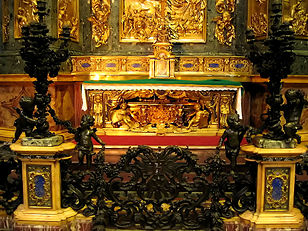
Tomb of Saint Ignatius, c. 1675
-
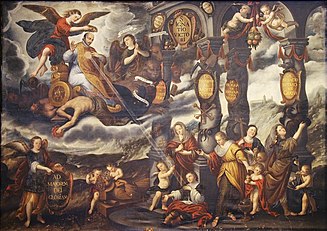
Apotheosis of Saint Ignatius
-

Portrait by Pieter Paul Rubens
-

Visions of Ignatius, 1617–18, Peter Paul Rubens
-

The journeys of Ignatius of Loyola at different times
-

A page from Spiritual Exercises
Bibliography
- The Spiritual Exercises of St Ignatius, TAN Books, 2010. ISBN 978-0-89555-153-5
- Ignatius of Loyola, Spiritual Exercises, London, 2012. limovia.net ISBN 978-1-78336-012-3
- Loyola, (St.) Ignatius (1964). The Spiritual Exercises of St. Ignatius. Anthony Mottola. Garden City: Doubleday. ISBN 978-0-385-02436-5.
- Loyola, (St.) Ignatius (1900). Joseph O'Conner (ed.). The Autobiography of St. Ignatius. New York: Benziger Brothers. OCLC 1360267. For information on the O'Conner and other translations, see notes in A Pilgrim's Journey: The Autobiography of Ignatius of Loyola Page 11-12.
- Loyola, (St.) Ignatius (1992). John Olin (ed.). The Autobiography of St. Ignatius Loyola, with Related Documents. New York: Fordham University Press. ISBN 0-8232-1480-X.













